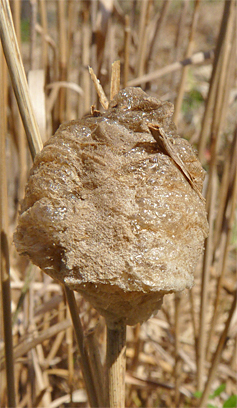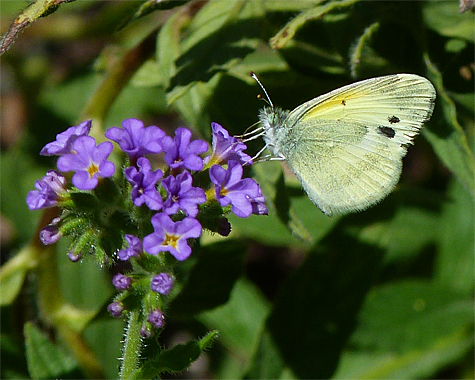Little did they know that while out for a fine, fall stroll the other day, Exec. Assistant, Leslie Pepple and Dev. Associate, Alicia Heacock would pick up a hitchhiker. After briefly talking to them as they passed through the Cafe Plaza here at the Museum I noticed a large insect clinging to Leslie as she turned to walk away.


Chinese Mantids are not native to North America but they are certainly well established here. They were brought in to this country to help control agricultural pests and are still sold in garden catalogues along with non-native Asian ladybugs as garden pest control agents.
The smaller, flightless (female) Carolina Mantid competes with this much larger mantid, and sometimes becomes the prey of its Chinese cousin. They are fearless, voracious predators. Chinese Mantids have been well documented as taking hummingbirds as prey!
Whatever you think of Chinese mantids, they’re here and are probably not going to go away anytime soon, if ever.
It’s a good thing that these mantids are not much larger, or Leslie would be in trouble. I’ve seen these guys stand their ground to people and even jump at them when threatened. But this was a gentle mantid, apparently secure in the fact that it had nothing to fear from either me or Leslie.

Later, as I sat in my office working on this Journal, a call came in on the radio from Richard Stickney saying that there was a Dainty Sulphur nectaring on the flowers of the garden in front of the Butterfly House. Since my office is in the Butterfly House and I could see Richard from a window in my office, I grabbed my camera and joined him in trying to get a photo of the little, yellowish butterfly.

Dainty Sulphurs are considered rare in North Carolina, although you wouldn’t know it by the amount of sightings in the state this year. They have been seen singly at several sites in the local area as well as a whopping 200 individuals at a sewage treatment plant in Forsyth County, NC.
The Dainty Sulphur’s normal range is Florida and the southwestern US.
Adult grasshoppers are beginning to make themselves known after a summer of feeding and molting into ever larger stages of development. I’ve seen several species including Bird Grasshopper and Differential Grasshopper, two of the largest hoppers in our area.
Looking at the photo of a Differential Grasshopper (below) I was reminded that these insects, grasshoppers in general, are built tough, like a tank. What looks like armor plating covers their bodies. All insects have a hard outer cover, an exoskeleton, but grasshoppers actually look as though they’re covered in plates of armor. This is especially so in the shape and size of the pronotum, the saddle-like structure between the head and the wings on a hopper.
I suppose that this armor is helpful considering all of the jumping and flying that these insects do. If you’ve ever seen a grasshopper land after hopping or taking flight, there’s usually a rough landing involved. Watch a grasshopper yourself sometime, the touchdown is typically less than graceful.

There’s lots of things going on outside at this time of year. After the heat of summer it’s good to get out and have a look around, things are changing quickly.
See you out there!
My Corgis love to eat grasshoppers. So do my chickens. What is all that armor plating good for?
Speaking of eating grasshoppers, there are many cultures world wide that consume grasshoppers. I have done so myself. When fried they make a delightfully crunchy snack.
It’s the armor plating that makes for such a crunchy delight,”Dig in.”